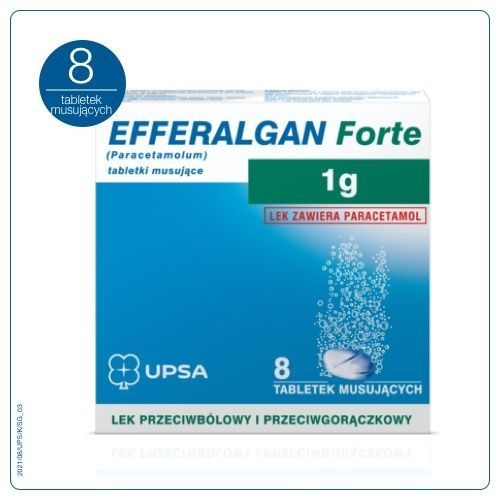

Efferalgan

Ask a doctor about a prescription for Efferalgan

How to use Efferalgan
Leaflet attached to the packaging: patient information
Warning! Keep the leaflet, information on the immediate packaging in a foreign language!
Efferalgan(Efferalganmed)
500 mg, effervescent tablets
Paracetamol
Efferalgan and Efferalganmed are different trade names for the same drug.
You should carefully read the contents of the leaflet before taking the medicine, as it contains important information for the patient.
This medicine should always be taken exactly as described in this patient leaflet or as directed by your doctor, pharmacist, or nurse.
- You should keep this leaflet so that you can read it again if you need to.
- If you need advice or additional information, you should consult a pharmacist.
- If you experience any side effects, including those not listed in this leaflet, you should tell your doctor, pharmacist, or nurse. See section 4.
- If pain does not improve in adults after 5 days, and symptoms of cold and flu or fever after 3 days, or if the patient feels worse, you should contact your doctor.
Table of contents of the leaflet
- 1. What is Efferalgan and what is it used for
- 2. Important information before taking Efferalgan
- 3. How to take Efferalgan
- 4. Possible side effects
- 5. How to store Efferalgan
- 6. Contents of the packaging and other information
1. What is Efferalgan and what is it used for
Efferalgan is a pain-relieving and antipyretic medicine. It lowers elevated body temperature. Paracetamol is less irritating to the stomach lining than salicylates.
Indications for use:
- Pain of various origins (headaches, toothaches, joint pain, muscle pain, menstrual pain, neuralgia, and others).
- Symptomatic treatment of flu-like conditions and colds.
- Fever. The medicine is intended for use in adults, adolescents, and children with a body weight of more than 17 kg (i.e., from about 6 years of age).
2. Important information before taking Efferalgan
When not to take Efferalgan
- in children with a body weight of less than 17 kg,
- in women during the first trimester of pregnancy,
Warnings and precautions
Before starting to take Efferalgan, you should discuss it with your doctor, pharmacist, or nurse.
Efferalgan contains paracetamol and should be taken into account when taking other medicines containing paracetamol (including prescription and over-the-counter medicines) to avoid taking a daily dose greater than recommended (see section 3).
Do not take higher doses than recommended. Taking higher doses than recommended carries the risk of very severe liver damage. Symptoms of liver damage usually appear 1 to 2 days after paracetamol overdose, with maximum severity usually occurring after 3-4 days.
Paracetamol may cause severe skin reactions (see section 4), such as acute generalized exanthematous pustulosis, Stevens-Johnson syndrome, and toxic epidermal necrolysis, which can be fatal. You should inform your doctor about skin reactions and stop taking the medicine if a skin rash or any other sign of allergy occurs.
You should consult your doctor before taking Efferalgan if you have any of the following conditions:
- liver function disorders, including Gilbert's syndrome (familial hyperbilirubinemia),
- kidney function disorders (see section 3),
- alcoholic disease,
- anorexia, bulimia, or cachexia,
- chronic malnutrition (low glutathione reserves in the liver),
- dehydration,
- hypovolemia (reduced blood volume).
Do not consume alcohol during treatment or take medicines containing alcohol.
During long-term (more than 3 months) use of painkillers in patients with chronic headache, when taken every other day or more frequently, medication-overuse headache (MOH) may develop or worsen. Medication-overuse headache should not be treated by increasing the dose. In such cases, you should stop taking painkillers in consultation with your doctor.
Efferalgan and other medicines
You should tell your doctor or pharmacist about all medicines you are taking or have recently taken, as well as any medicines you plan to take.
Concomitant use of Efferalgan may alter the effect of the following medicines or the use of the following medicines may alter the effect of concomitantly used Efferalgan:
- MAO inhibitors - concomitant use is contraindicated with MAO inhibitors and for 2 weeks after stopping treatment with these medicines due to the possibility of excitement and high fever.
- Medicines containing salicylamide (a pain reliever also used in febrile conditions) - concomitant use prolongs the elimination of paracetamol.
- Medicines that increase liver metabolism - concomitant use of paracetamol and medicines such as St. John's wort, antiepileptic drugs, barbiturates (mainly used in epilepsy), rifampicin (used in tuberculosis) may lead to liver damage, even when recommended doses of paracetamol are used (see "Use of a higher than recommended dose of Efferalgan" in section 3). Caution should be exercised when used concomitantly.
You should inform your doctor about the use of this medicine if your doctor prescribes a test for uric acid or blood sugar.
Using Efferalgan with alcohol
During treatment, you should not consume alcohol or take medicines containing alcohol, due to the increased risk of toxic liver damage.
Pregnancy, breastfeeding, and fertility
If you are pregnant or breastfeeding, think you may be pregnant, or plan to have a child, you should consult your doctor before taking this medicine. Efferalgan can be given to pregnant women if necessary. You should use the smallest effective dose that relieves pain or reduces fever and take the medicine for the shortest possible time and as infrequently as possible. Paracetamol may be used during breastfeeding only with the doctor's consent and in individual cases. You should exercise caution while taking the medicine during lactation. If pain is not relieved or fever does not subside, or if it is necessary to increase the frequency of taking the medicine, you should consult your doctor. There is no available, sufficient data to demonstrate the effect of paracetamol on fertility.
Driving and using machines
Efferalgan does not affect psychophysical abilities. There are no contraindications to driving vehicles and operating machinery.
Efferalgan contains sodium, sorbitol, and sodium benzoate.
Each effervescent tablet contains 412 mg of sodium (the main component of table salt). This corresponds to 21% of the maximum recommended daily intake of sodium in the diet for adults. If you take 1 or more effervescent tablets per day for a long time, patients, especially those controlling sodium intake in their diet, should contact their doctor or pharmacist.
Each effervescent tablet contains 300 mg of sorbitol. Sorbitol is a source of fructose. If you have previously been diagnosed with intolerance to some sugars or hereditary fructose intolerance (a rare genetic disorder in which the patient's body does not break down fructose), you should contact your doctor before taking the medicine or giving it to your child. Sorbitol may cause gastrointestinal discomfort and may have a mild laxative effect.
Efferalgan contains sodium benzoate, which may increase the risk of jaundice (yellowing of the skin and whites of the eyes) in newborns (up to 4 weeks of life) whose mothers took this medicine during pregnancy.
3. How to take Efferalgan
This medicine should always be taken exactly as described in this patient leaflet or as directed by your doctor, pharmacist, or nurse. If you have any doubts, you should consult your doctor, pharmacist, or nurse.
The dose is determined based on the patient's body weight. The approximate age corresponding to a given body weight is provided only as a guide. The recommended single dose of paracetamol is 10 to 15 mg/kg body weight, every 4 to 6 hours, up to a maximum daily dose of 75 mg/kg body weight.
The total daily dose of paracetamol should not exceed 4 g.
The recommended dose is:
Adults and adolescents with a body weight over 50 kg (over 15 years of age)
The recommended single dose of Efferalgan is 500 mg or 1 g of paracetamol (one or two effervescent tablets), every 4 to 6 hours, for a total of no more than 3 g of paracetamol (6 effervescent tablets per day). However, in case of severe pain, the daily dose can be increased to a maximum of 4 g of paracetamol (8 effervescent tablets per day). You should always maintain at least a 4-hour interval between doses.
Children and adolescents with a body weight of up to 50 kg
The recommended single dose of paracetamol is 10 to 15 mg/kg body weight, preferably every 6 to 8 hours, with a maximum daily dose of 60 mg/kg body weight per day.
Children with a body weight of 17 to 25 kg (6 to 8 years old): the single dose is 250 mg of paracetamol (half an effervescent tablet). If necessary, the dose can be repeated every 6 hours. Do not take more than 1 g of paracetamol per day (2 effervescent tablets).
Children with a body weight of 25 to 33 kg (8 to 10 years old): the single dose is 250 mg (half an effervescent tablet). If necessary, the dose can be repeated every 4-6 hours. Do not take more than 1.5 g of paracetamol per day (3 effervescent tablets).
Children with a body weight of 33 to 50 kg (10 to 15 years old): the single dose is 500 mg (one effervescent tablet), which can be repeated every 6 hours if necessary. Do not take more than 2 g of paracetamol per day (4 effervescent tablets).
Elderly patients
There is no need to modify the dose.
Patients with renal impairment
The recommended single dose is 500 mg (1 effervescent tablet), and the minimum interval between doses should be in accordance with the following schedule:
Creatinine clearance
Interval between doses
CrCl ≥ 50 ml/min
4 hours
CrCl 10-50 ml/min
6 hours
CrCl <10 ml min
8 hours
Patients with liver function disorders
In patients with liver function disorders, the dose of the medicine should be reduced or the intervals between doses prolonged. In the following situations, the maximum daily dose should not exceed 60 mg/kg body weight per day (should not exceed 2 g/day):
- in patients with a body weight below 50 kg,
- chronic or compensated active liver disease, especially mild to moderate liver failure,
- Gilbert's syndrome (familial non-hemolytic hyperbilirubinemia),
- chronic alcoholic disease,
- chronic malnutrition (low glutathione reserves in the liver),
- dehydration.
Method of administration
Oral administration. The effervescent tablet should be dissolved in a glass of water and the prepared solution drunk. Do not chew or swallow the tablets.
Frequency of administration
To prevent periodic worsening of pain or fever:
- in children, you should maintain a regular interval between doses both during the day and at night,
- in adults, the interval between doses should not be less than 4 hours.
Duration of treatment
In adults, do not take the medicine without a doctor's recommendation for more than 5 days in case of pain, and for more than 3 days in case of cold and flu or fever. In children and adolescents, never take the medicine for more than 3 days.
Taking a higher than recommended dose of Efferalgan
In case of taking too high a dose or accidental ingestion of Efferalgan, you should contact your doctor for appropriate advice.
Overdose is particularly dangerous in the elderly, small children, patients who are chronically malnourished, have liver disease, and patients taking medicines that induce liver enzymes, as these individuals have an increased risk of liver damage.
Overdose of the medicine may cause symptoms such as nausea, vomiting, loss of appetite, pallor, excessive sweating, drowsiness, and general weakness within a few to several hours. These symptoms may subside the next day, despite the fact that liver damage is beginning to develop, manifested by abdominal distension, return of nausea, and jaundice. In every case of taking this medicine in a single dose of 5 g of paracetamol or more, you should induce vomiting if it has been no more than an hour since ingestion and contact your doctor immediately. It is recommended to administer 60-100 g of activated charcoal orally, preferably mixed with water. You should seek medical advice immediately.
Rare cases of acute pancreatitis have been observed.
Missing a dose of Efferalgan
Do not take a double dose to make up for a missed dose.
If you have any further doubts about taking this medicine, you should consult your doctor, pharmacist, or nurse.
4. Possible side effects
Like all medicines, this medicine can cause side effects, although not everybody gets them.
The frequency of side effects listed below is defined as follows:
common: in less than 1 in 100 but more than 1 in 1,000 patients treated,
rare: in less than 1 in 1,000 but more than 1 in 10,000 patients treated,
very rare: in less than 1 in 10,000 patients treated,
not known: frequency cannot be estimated from the available data.
Rare: lowering of blood pressure.
Very rare: tachycardia; nausea, vomiting; renal colic, renal papillary necrosis, acute renal failure.
Not known: anaphylactic reaction (including hypotension), anaphylactic shock, hypersensitivity reactions, angioedema (swelling of the deep layers of the skin and subcutaneous tissue); diarrhea, abdominal pain; increased liver transaminase activity; thrombocytopenia (reduced platelet count), leukopenia (reduced white blood cell count), neutropenia (reduced neutrophil count); rash, erythema, urticaria, purpura, acute generalized exanthematous pustulosis, toxic epidermal necrolysis, Stevens-Johnson syndrome.
Very rare, requiring withdrawal of treatment, cases of hypersensitivity reactions (skin redness, dyspnea, bronchospasm, excessive sweating) have been reported.
Reporting side effects
If you experience any side effects, including those not listed in this leaflet, you should tell your doctor, pharmacist, or nurse. Side effects can be reported directly to the Department of Drug Safety Monitoring of the Office for Registration of Medicinal Products, Medical Devices, and Biocidal Products, Al. Jerozolimskie 181C, PL-02 222 Warsaw, Tel.: + 48 22 49 21 301, Fax: + 48 22 49 21 309, website: https://smz.ezdrowie.gov.pl
By reporting side effects, you can help provide more information on the safety of this medicine.
5. How to store Efferalgan
The medicine should be stored out of sight and reach of children.
There are no special precautions for storage.
Do not use this medicine after the expiry date stated on the packaging. The expiry date refers to the last day of the month stated.
Medicines should not be disposed of via wastewater or household waste. You should ask your pharmacist how to dispose of medicines that are no longer needed. This will help protect the environment.
6. Contents of the packaging and other information
What Efferalgan contains
The active substance of the medicine is paracetamol. Each effervescent tablet contains 500 mg of paracetamol.
The other ingredients are: citric acid, sodium carbonate, sodium bicarbonate, sorbitol, sodium saccharin, sodium docusate, povidone, sodium benzoate.
What Efferalgan looks like and contents of the packaging
Effervescent tablet.
Packaging: soft aluminum/PE blisters containing 16 effervescent tablets, in a cardboard box.
For more detailed information, you should contact the marketing authorization holder or parallel importer.
Marketing authorization holder in France, in the country of export:
UPSA SAS
3, rue Joseph Monier
92500 Rueil-Malmaison
France
Manufacturer:
UPSA SAS
979, avenue des Pyrénées
47520 Le Passage
France
UPSA SAS
304, avenue du Docteur Jean Bru
47000 Agen
France
Parallel importer:
Medezin Sp. z o.o.
ul. Zbąszyńska 3
91-342 Łódź
Repackaged by:
Medezin Sp. z o.o.
ul. Zbąszyńska 3
91-342 Łódź
Marketing authorization number in France, in the country of export: 34009 325 700 1 0
325 700-1
Parallel import authorization number: 88/19
Date of leaflet approval: 07.03.2024
[Information about the trademark]
- Country of registration
- Active substance
- Prescription requiredNo
- Marketing authorisation holder (MAH)UPSA SAS
- This information is for reference only and does not constitute medical advice. Always consult a licensed doctor before taking any medication. Oladoctor is not responsible for medical decisions based on this content.
- Alternatives to EfferalganDosage form: Tablets, 500 mgActive substance: paracetamolManufacturer: Farmaceutyczna Spółdzielnia Pracy "Galena"Prescription not requiredDosage form: Tablets, 300 mgActive substance: paracetamolManufacturer: Farmaceutyczna Spółdzielnia Pracy "Galena"Prescription not requiredDosage form: Tablets, 325 mgActive substance: paracetamolManufacturer: US Pharmacia Sp. z o.o.Prescription not required
Alternatives to Efferalgan in other countries
The best alternatives with the same active ingredient and therapeutic effect.
Alternative to Efferalgan in Spain
Alternative to Efferalgan in Ukraine
Online doctors for Efferalgan
Discuss dosage, side effects, interactions, contraindications, and prescription renewal for Efferalgan – subject to medical assessment and local rules.















